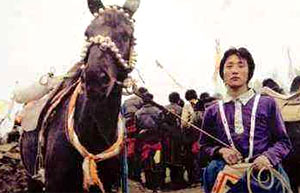
Tsering Tashi, who set fire to himself and died on January 12, 2013.
A harrowing video that has been posted online of Tsering Tashi’s self-immolation depicts him lying on the street in flames, lifting his hands into a prayer position and saying the name of the Dalai Lama in a voice that remains steady as he speaks.
Following Tsering Tashi’s self-immolation in the main street of Amchok township on January 12, Chinese police and Public Security Bureau officials arrived in several vehicles. They barred the monks of Amchok monastery and local lay Tibetans from offering prayers and ordered Tsering Tashi’s family members to cremate the body as soon as possible. When the family initially said that they needed to perform the customary religious rituals for a death, they were threatened and told that they would be responsible for the consequences if they refused.
Amchok township is located in Sangchu (Chinese: Xiahe) county, Gannan Tibetan Autonomous Prefecture, Gansu province (the traditional Amdo area of Tibet). The authorities’ handling of this incident reflects official efforts attempt to prevent Tibetans from gathering following self-immolations even for peaceful prayer ceremonies. The self-immolations in Tibet reached an unprecedented level of intensity late last year, with 28 in November 2012 alone, and many of them were followed by gatherings of hundreds, sometimes thousands of Tibetans to say prayers and chant mantras for their passing.
In an apparent effort to deter Tibetan self-immolations, the Chinese Communist Party announced in December, 2012, criminal penalties for “Anyone who organizes, plots, incites, coerces, entices, abets, or assists others to commit self-immolations,” warning that such persons “shall be held criminally liable for intentional homicide in accordance with the Criminal Law.” (Those Who Incite Self-Immolations Must be Severely Punished Under the Law, Gannan Daily, December 3, 2012. Translation into English by Dui Hua).
Tsering Tashi, who was from a farming family in the village of Kyi, a short walk from Amchok town, was the first Tibetan to set fire to himself in 2013.
According to relatives of Tsering Tashi who are in exile, the authorities threatened the family after his self-immolation, with one official accusing them of having close ties with the “splittist Dalai group.” When Tsering Tashi’s mother was told of the order to cremate him straight away, without carrying out the traditional rituals, she fainted and had to be taken to hospital, according to the same sources. Tsering Tashi’s body was cremated late on Sunday night (January 13), when most people were asleep, and the Chinese authorities allowed only a few people to attend the cremation.
Tsering Tashi was married to Yumtso Kyi and is survived by his wife, parents and two sisters. He was described by Tibetans who knew him as “good-natured and polite” with a keen passion for horses and horse racing. A Tibetan in exile who knows his family told ICT that he was educated to 10th grade level. The same Tibetan said that the self-immolation had been a complete shock to the family, as he had not talked about it. The Tibetan in exile said: “He did have a strong feeling about the need for the Dalai Lama to come home, and I hear he had talked about that recently. He was aware of self-immolations that had happened in Amchok and other places. People are dying for the Dalai Lama. There is no doubt about that.”
Tsering Tashi is the fourth Tibetan in Amchok to set fire to himself, following the self-immolations last year of Lhamo Tseten on October 26, 18-year old Kunchok Tsering on November 26 and Tserung Dhundup, 35, on November 20.

